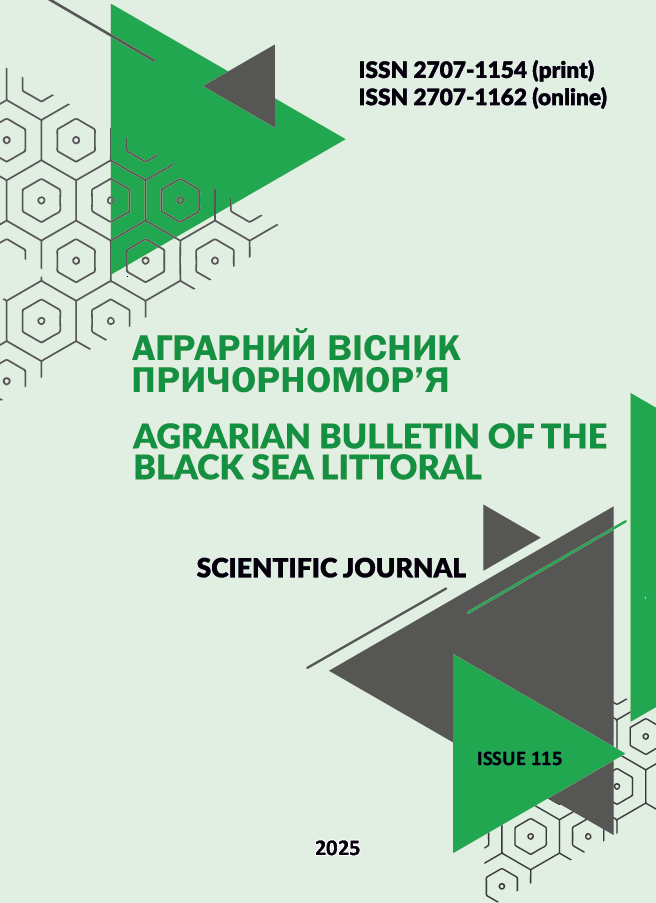ANALYSIS OF BLUETONGIC INCIDENCE IN THE WORLD FOR THE PERIOD 2020-2025
DOI:
https://doi.org/10.37000/abbsl.2025.115.02Keywords:
bluetongue, epizootic situation, pathogen, insects, transmissible diseasesAbstract
Monitoring studies have been conducted on the spread of bluetongue in countries around the world from 2020 to 2025.
The distribution of the bluetongue pathogen in the world was determined by analyzing data from the World Organization for Animal Health.
The spread of the bluetongue pathogen was mainly through vectors - midges of the genus Culicoides. The causative agent of the disease was diagnosed in the following animals: cattle, sheep, goats, domestic camels, domestic and red deer, fallow deer, mouflon, Pyrenean chamois, and western roe deer.
It was found that between 2020 and 2025, the disease was recorded in 23 countries around the world. In 2020, blue tang was recorded in 7 countries: Switzerland, Cyprus, Germany, Algeria, North Macedonia, Romania, and Luxembourg. In 2021, the disease was observed in 8 European countries: Serbia, Romania, Switzerland, Spain, Croatia, Bosnia and Herzegovina, Portugal, Germany, and one African country: Algeria. In 2022, 6 countries were unfavorable for bluetongue: Albania, Belgium, Spain, Portugal, Bulgaria, Mayotte. In 2023, the disease was recorded in Montenegro and Cyprus. The disease spread and in 2024 was detected in 14 countries: Great Britain, Denmark, Iraq, Italy, Spain, Luxembourg, Germany, the Netherlands, Palestine, North Macedonia, Portugal, Switzerland, Sweden and Croatia.
An analysis of reports from the World Organization for Animal Health over five years showed that 467184 favorable animals were registered, of which 147094 (31.49 %) were registered in 2020, 9278 (19.9 %) in 2021, 11786 (2.52 %) in 2022, 1378 (0.29 %) in 2023, and 297648 (63.71 %) in 2024. The number of cases of the disease was 21022, of which 4620 (21.98 %) were in 2020, 173 (0.83 %) in 2021, 264 (1.26 %) in 2022, 20 (0.09 %) in 2023, and 15945 (75.84 %) in 2024. The total number of animal deaths was 5706 animals, of which 1699 (29.78 %) were in 2020, 8 (0.14 %) in 2021, 52 (0.91 %) in 2022, and 3947 (69.17 %) in 2024.
In the first quarter of 2025, 481821 cases were registered, of which the number of susceptible animals was 467057 (96.9 %), the number of diseases was 12354 (2.6 %), and deaths were 2410 (0.5 %).
References
Saminathan M, Singh KP, Khorajiya JH, Dinesh M, Vineetha S, Maity M, et al. (December 2020). "An updated review on bluetongue virus: epidemiology, pathobiology, and advances in diagnosis and control with special reference to India". The Veterinary Quarterly. 40 (1): 258–321.
Alkhamis MA, Aguilar-Vega C, Fountain-Jones NM, Lin K, Perez AM, Sánchez-Vizcaíno JM (December 2020). "Global emergence and evolutionary dynamics of bluetongue virus". Scientific Reports. 10 (1): 21677.
"Bluetongue". Wageningen University & Research. 2024-12-12. Retrieved 2024-12-12.
Brink KM, Santman-Berends IM, Harkema L, Scherpenzeel CG, Dijkstra E, Bisschop PI, et al. (August 2024). "Bluetongue virus serotype 3 in ruminants in the Netherlands: Clinical signs, seroprevalence and pathological findings". The Veterinary Record. 195 (4): e4533.
Purse BV, Mellor PS, Rogers DJ, Samuel AR, Mertens PP, Baylis M (February 2005). "Climate change and the recent emergence of bluetongue in Europe". Nature Reviews. Microbiology. 3 (2): 171–181.
Baylis M, Caminade C, Turner J, Jones AE (August 2017). "The role of climate change in a developing threat: the case of bluetongue in Europe". Revue Scientifique et Technique. 36 (2): 467–478.
"Bluetongue in Europe: How climate change is shifting disease patterns". WOAH - World Organisation for Animal Health. Retrieved 2024-12-12.
Gao H, Wang L, Ma J, Gao X, Xiao J, Wang H (29 October 2021). "Modeling the current distribution suitability and future dynamics of Culicoides imicola under climate change scenarios". PeerJ. 9: e12308.
Savini G. (2015). Bluetongue: a disease that does not speak ‘one tongue’ only. Vet. Ital., 51, 247–248.
Belbis G., Zientara S., Breard E.,Sailleau C., Caignard G.,Vitour D. & Attoui H. (2017). Bluetongue virus: From BTV-1 to BTV-27. Adv. Virus Res., 99, 161–197.
Reviriego Gordejo F.J. (2013). – Bluetongue in Europe: lessons learned. Proc. U.S. Anim. Hlth Assoc., 117, 141–142.
Downloads
Published
How to Cite
Issue
Section
License

This work is licensed under a Creative Commons Attribution-NonCommercial 4.0 International License.


